Fri 27 Aug 2021
Where have all the badgers gone?
Posted by DavidMitchell under Uncategorized
Comments Off on Where have all the badgers gone?
To get away from the present grim realities of human society, as were discussed here last week, this week we’ll take a few looks at the fascinating realities of the non-human society that’s seen around Mitchell cabin.

This past week, my wife Lynn spotted a bobcat in a persimmon tree next to our front steps. It’s not that we live in a literal zoo. Bobcats are fairly common here and elsewhere in Point Reyes Station.
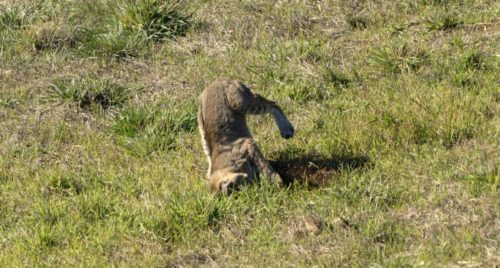
Pouncing. A bobcat pounces on a gopher not far from our deck.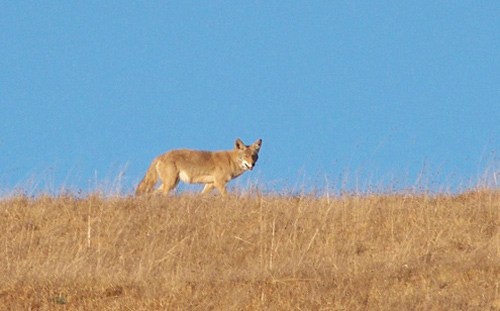
Coyotes. Predators even more noticeable are the coyotes. This one is looking at my parked car. Most nights the coyotes on this hill howl to establish territory. Contrary to widespread opinion, coyotes do not howl to announce a kill, for that would invite other coyotes to steal the prey.

Grey foxes are another set of predators we see fairly often. These are just outside the kitchen door scouring up the last of the kibble I had earlier given to some raccoons.
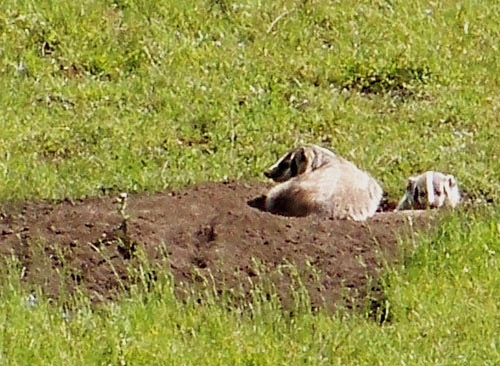
Badgers. Where did they go? When I first moved to this hill 45 years ago, there were a number of badger burrows. I spotted this pair one morning when I looked up from the breakfast table. They were easily visible on a nearby hillside. From their burrow’s entrance, the sow and cub were keeping an eye on the world. New badger holes used to be annual events here, but I haven’t seen a new one in five years or more.

Chipmunks are totally absent from our hill. This one apparently wandered over from Inverness Ridge a decade ago, but it didn’t stick around.
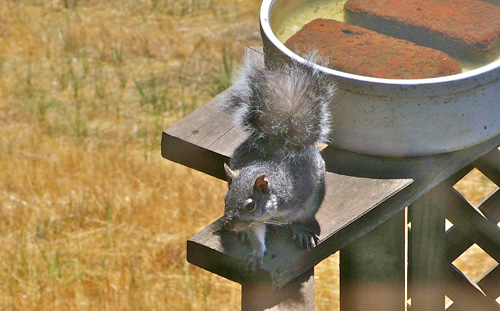
Gray squirrels can be a nuisance, and controlling them is an annual topic for discussion around here. The squirrels like to eat the cambium layer just under the bark on pines, often killing the ends of the limbs they munch on.
 The possums we see around here are Virginia Opossums, which are native to North America. Their lifespan is typically around four years. Possums are marsupials with counterparts found in Central and South America, New Zealand, and Australia.
The possums we see around here are Virginia Opossums, which are native to North America. Their lifespan is typically around four years. Possums are marsupials with counterparts found in Central and South America, New Zealand, and Australia.
To quote Wikipedia: “A marsupial is a mammal that raises its newborn offspring inside an external pouch at the front or underside of their bodies. In contrast, a placental is a mammal that completes embryo development inside the mother, nourished by an organ called the placenta.”

A jack rabbit in our backyard. As noted here before: “Jackrabbits were named for their ears, which initially caused some people to refer to them as ‘jackass rabbits.’ The writer Mark Twain brought this name to fame by using it in his book of western adventure, Roughing It. The name was later shortened to jackrabbit.”
Raccoons and skunks end up eating together so often they get along with each other fairly well.
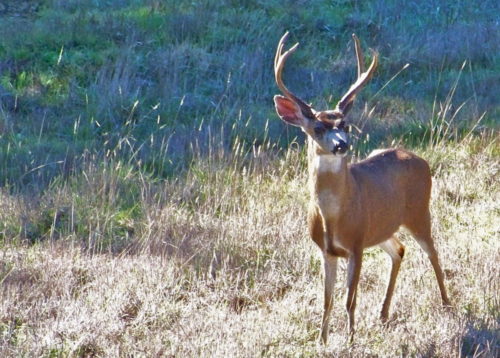
A blacktail buck makes his daily appearance grazing beside Mitchell cabin. Of all the creatures I see, the bucks seem to have the most regal bearing.

No Responses to “ Where have all the badgers gone? ”
Sorry, comments for this entry are closed at this time.